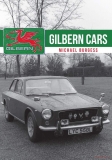Úvod »Automobily osobní a dodávky»Lola » Gilbern - A Dragon's tale
Anotace
| Vazba: | Vázaná | ||
| Počet stran: | 272 | ||
| Rozměry v mm: | n/a | ||
| Počet obrázků: | 300 | ||
| Rok vydání: | 2020 | ||
During Gilbern Cars existence – 1960 to 1974 – the marque had the distinction of being Wales’ only production car manufacturer. Esteemed motoring author Martin Morgan-Jones has captured the capricious history of the low volume Welsh car maker in his book, ‘Gilbern – A Dragons Tale’, greatly assisted by the comprehensive database compiled by Philip Ivimey, archivist at the Gilbern Owners Club, who receives due credit for his work on the book’s attractive jacket.
Gilbern took its charismatic name from a combination of its founders’ Christian names; Giles Smith, a butcher, and Bernard Friese, a German ex-prisoner of war and engineer, who met at a South Wales roadside. Like so many of the other cars built using components from high-volume motor manufacturers proprietary models – BMC and later Ford – a Gilbern GT was first offered in kit-form, though quickly became a fully-assembled, well-engineered and practical car, albeit expensive when compared with its competitors.
This well-written book includes interviews with most of the principals involved during the life of the Company, together with their passion and fight for survival. But despite a full order book, the extremely well-built and versatile GT cars were blighted by the lack of long-term committed investors and regular component delivery problems.
Other facts include model developments, technical details, accounts of several variations, sales strategy and the Company’s successes, together with several changes of ownership. Also included is a concise five-page ‘timeline’ and lists of dealers and prices. In a quest to secure a high-profile customer in 1969, the Prince of Wales, then a Welsh Language student at Aberystwyth University, was loaned a Kingfisher Blue Gilbern Genie, but he finally opted for a Mineral Blue MGC GT. No discount was requested by HRH or offered by Gilbern who, at the time, simply could not afford it.
For motor sport enthusiasts the book has a chapter dedicated to Gilbern’s competition record, both in period as well as subsequent use in historic events, including the Spa Six-Hours race. Although Gilbern decided not to officially participate, based on cost, wealthy privateers raced, hill climbed and sprinted successfully in the Welsh company’s cars at numerous premier national events during the 1960s.
Prolific Welsh racing driver Peter ‘Taffy’ Cottrell, who was a founder-director of Gilbern Sports Cars, played unofficial ‘works’ driver. He also raced a 4.5-litre Chevrolet engine GT with Lister/Jaguar gearbox and parts taken from an ex-Tony Marsh BRM. Ken Wilson, a sprint champion with more money than talent, encouraged Cottrell to race the Leviathan created for him at the Llantwit Fardre factory. In 1968 a Gilbern Genie competed in the Motoring News Championship Cilwendeg Rally.
It’s even mooted that in 1964 an entry in the Le Mans 24 Hours race for a team of three FIA-homologated MGB-engine GT 1800s was considered, to be driven by Peter Cottrell, Ken Wilson, RAC Rally winner Lyndon Sims and ex-F1 driver Jack Lewis. But for reasons not recalled in the book, the race entries were never submitted, although some of these potential drivers were present with GT 1800 road cars.
This is a thumping good read and limited to just 500 numbered hardback copies. My copy was 383 so sales have been vigorous despite its launch during the Coronavirus lockdown.



























